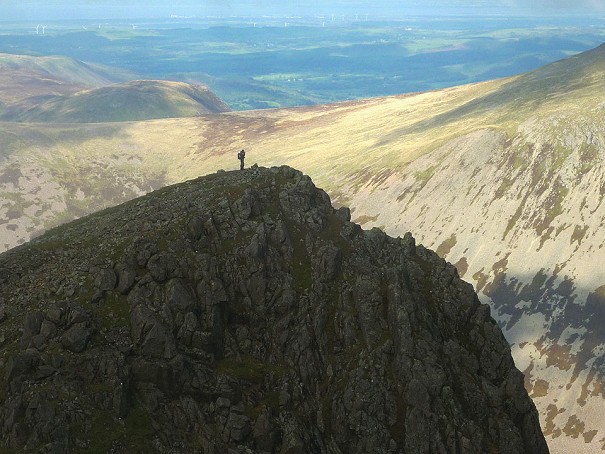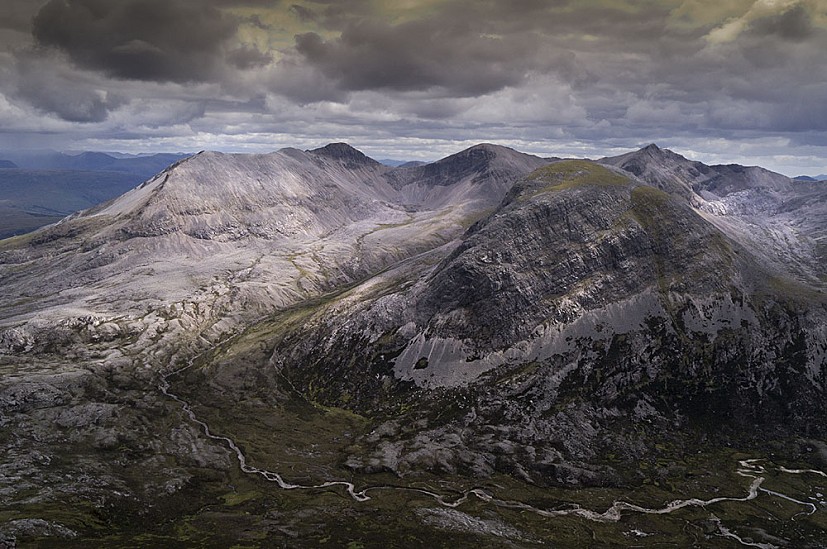
One Minute Mountain Steeple
From some angles it's all drama; from others it's hardly there at all. Steeple is a fell with extremes of personality, says Alex Roddie, in our ongoing series of bite sized intros to Britain's favourite hills.
Alex Roddie explores one of Torridon's finest, the complex and dramatic Beinn Eighe massif.
Height: 1010m
Personality: Few would deny that Beinn Eighe is one of the best mountains in Scotland, if not the UK. It's really an entire mountain range comprising several distinct summits, two of which are Munros ( Beinn Eighe - Ruadh-stac Mor, 1010m, and Beinn Eighe - Spidean Coire nan Clach, 993m). While the southern flank presents a near-unbroken wall of quartzite screes and heather, the north side is a vast and wild region of remote corries, crags, buttresses and pinnacles. On the map, it looks a bit like a dinosaur's footprint, with Sail Mhor, Ruadh-stac Mor, Ruadh-stac Beag and Creag Dhubh as the toes. This is a mountain to savour and explore over multiple visits.
What's in a name? Beinn Eighe is Gaelic for 'file mountain', thought to describe its serrated outline.
Best route: The classic route taking in both Munros is probably the best all-round walking route on this hill, and certainly the most popular. Steeply ascend Coire an Laoigh from Glen Torridon to the south (the true summit is a little along the ridge from the trig point) then continue west to Ruadh-stac Mor, where the summit views are superb. The route then descends loosely and steeply into Coire Mhic Fhearchair – one of the most impressive mountain corries in Scotland, where the huge Triple Buttress frowns down on the waters of the loch. This is a favoured spot for landscape photographers, and with good reason. The route then descends easily on a good path back to Glen Torridon.
Anything for scramblers? There are a number of scrambling possibilities on Beinn Eighe, although many are actually low-grade rock climbs in serious big-mountain locations. A more modest scrambling challenge takes in the Black Carls. A steep ascent from Kinlochewe leads to a sharp, pinnacled ridge offering blocky scrambling and some exposure, but it isn't a serious route for experienced scramblers. It's often used as a prelude to a complete traverse of the mountain. In winter the route is a grade I/II climb, and best left to experienced winter mountaineers.
And what about backpackers? The section of the Cape Wrath Trail encircling Beinn Eighe is arguably the best bit of the whole route. The CWT is a long-distance trail from Fort William to Cape Wrath. Although there are many possible variants, walkers shouldn't miss the leg 'around the back' of Beinn Eighe. After a visit to Coire Mhic Fhearchair to take in the splendour of the Triple Buttress, there's a long and beautifully wild off-path section beneath the mountain's northern battlements, with some great spots for wild camping.

What's special about the Triple Buttress? The Triple Buttress is a tall cliff rising above the waters of Loch Coire Mhic Fhearchair. As you'd expect from the name, this feature consists of three steep rock towers divided by deep gullies. The cliff is divided top and bottom by a clear line – the rock below this line is sandstone, while above is quartzite. In addition to being one of Scotland's most celebrated climbing crags, it was also the location of a famous aircraft accident in 1951, when a Lancaster bomber collided with the top of the cliffs, killing all eight crew members. Wreckage can still be seen in the corrie, notably in Fuselage Gully itself, where climbers have to climb past a twisted aircraft propeller – it's often used as an anchor point.
An oasis of wildness: Wildness is perhaps this mountain's defining quality. Beinn Eighe became Britain's first National Nature Reserve in 1951. On the eastern fringes of the mountain, you'll find the internationally significant pinewoods of Coille na Glas-Leitre, where a lengthy programme of woodland regeneration has nurtured an ancient fragment of Caledonian forest and helped it to regenerate, offering improved habitat for the wildlife that lives there. Research shows that these Scots pines, some of which are up to 350 years old, are genetically distinct from pines in other parts of the Highlands.
Hidden gem: For a dose of isolation, head up into Coire Ruadh-staca. What this corrie lacks in soaring cliffs it makes up for in a beautiful network of water, heather and rock – a quiet place for contemplation and sky-watching. You almost certainly won't meet anyone else.
Where to stay? Torridon Youth Hostel makes a good base. In Kinlochewe, the Kinlochewe Hotel offers both hotel rooms and a bunkhouse. If you'd prefer to camp, there's a large campsite at Kinlochewe or a small, free campsite at Torridon (minimal facilities)
Accommodation Advertise here
No Premier Listings found in this area
Instructor/Guides Advertise here
No Premier Listings found in this area
Outdoor Shops Advertise here
No Premier Listings found in this area

Comments